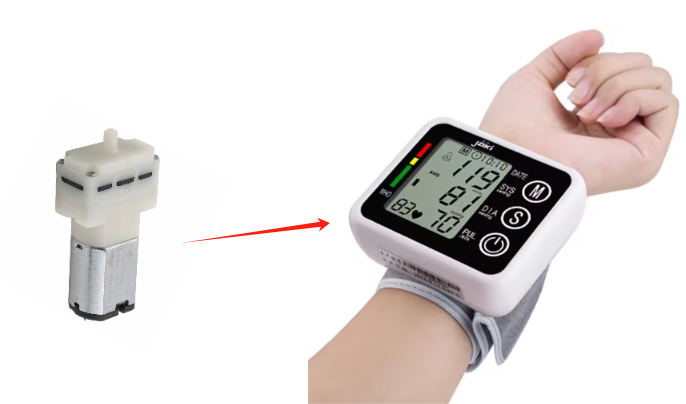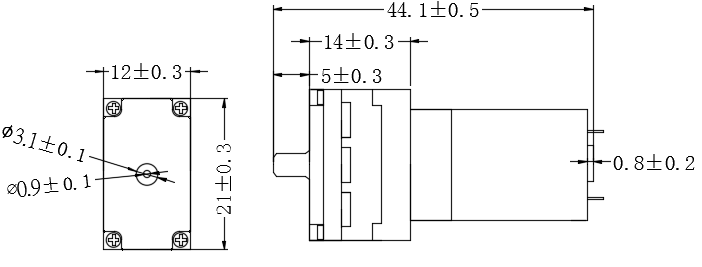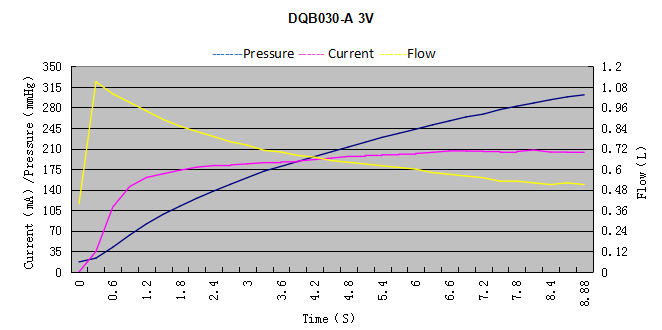Video
1 / 5
Mini Air Pump Diaphragm Pump For Wrist BPM
$1.52
≥1000 Piece/Pieces
$1.21
≥10000 Piece/Pieces
Types:
- Diaphragm Pumps
| Model No. : | DQB030-A |
|---|---|
| Brand Name : | Deyuxin |
| Model Number : | DQB030-A |
Shenzhen, Guangdong, China
- Manufacturer
- Gold Supplier

- Platform Certification

- SGS Certification
- Video

Product description
What is the air pump on a blood pressure monitor?
The air pump on the sphygmomanometer is a key component of the sphygmomanometer. Its main function is to provide the required air pressure control during blood pressure measurement. This pump is usually responsible for inflating the blood pressure cuff so that it can apply enough pressure to block blood flow when measuring blood pressure.
The working principle of a sphygmomanometer air pump is relatively simple but very effective. It usually contains a small electric motor or air pump that kicks in when the sphygmomanometer is turned on to take a blood pressure measurement, pumping air into the cuff. As the pressure within the cuff increases, it gradually compresses the blood vessels until blood flow is completely blocked.
During the inflation process, the sphygmomanometer monitors the pressure within the cuff and uses a certain algorithm to record and analyze the pressure value when the blood flow is blocked. This pressure value is the measurement result of blood pressure, including systolic blood pressure and diastolic blood pressure.
Once the blood pressure measurement is complete, the air pump begins to deflate, gradually reducing the pressure within the cuff so that the patient can comfortably remove the cuff. This process is automatic and precisely controlled by the blood pressure monitor's control circuit.

How much air does a miniature diaphragm air pump need to pump into a wrist blood pressure monitor?
When the micro-diaphragm air pump pumps air into the wrist sphygmomanometer, the pressure that needs to be achieved depends on the design and requirements of the wrist sphygmomanometer, as well as the specific conditions of the person being measured. Different blood pressure monitors have different pressure ranges and inflation speed requirements to adapt to the blood pressure measurement needs of different people.
During blood pressure measurement, a micro-diaphragm air pump needs to gradually inflate the cuff of the blood pressure monitor until the pressure in the cuff is enough to block blood flow. The minimum pressure required to block blood flow is the systolic blood pressure. The blood pressure monitor then records the pressure at which blood flow restarts as the pressure in the cuff gradually decreases, known as the diastolic pressure.
Therefore, the amount of air that the micro-diaphragm air pump needs to pump is not fixed, but is dynamically adjusted based on the instructions of the blood pressure monitor and feedback from the pressure sensor. The blood pressure monitor controls the operation of the air pump to ensure that the pressure in the cuff reaches the appropriate level during the measurement.
Technical Specification
| Model | DQB030-A | Voltage | dc3v 6v 9v |
| Current | 350mA 200mA,120mA | Flow | 0.5-1.2LPM |
| Pressure | 360-550mmHg | Media | Air |
| Net weight | 15g | Noise | 58dB |
Why does the micro diaphragm air pump increase the pressure when pumping air?
The principle of the micro diaphragm air pump to increase pressure when pumping air is mainly related to its working mechanism and structural characteristics.
As a reciprocating positive displacement pump, the core component of the miniature diaphragm air pump is the diaphragm. When the air pump is working, the circular motion of the motor causes the diaphragm inside the pump to reciprocate through the mechanical device. This movement causes the air in the pump chamber to be compressed and stretched, thereby forming a negative pressure at the air suction port, creating a pressure difference with the outside atmospheric pressure. Due to the existence of this pressure difference, the gas is sucked into the pump chamber and, driven by the diaphragm, is discharged through the exhaust port. Therefore, with the constant movement of the diaphragm, the pump
The pressure inside gradually builds up and increases.
During the air pumping process of the micro diaphragm air pump, due to the continuous reduction of the volume of the pump chamber (compression stage), the gas molecules are compressed together, causing the gas pressure to increase. It's basic physics that as a gas decreases in volume, its pressure increases. At the same time, due to the efficient sealing performance of the micro diaphragm air pump, it can effectively prevent gas leakage, thereby ensuring that the pressure inside the pump can continue to increase steadily.
In addition, micro diaphragm air pumps usually have a built-in pressure automatic switch control protection function. When the pressure reaches a preset value, the air pump will automatically stop working to avoid damage caused by overpressure. This automatic control function also helps ensure the stability and safety of the air pump during air pumping.
Dimension Drawing
Size:MM

How does the micro diaphragm air pump ensure accurate measurement in a wrist blood pressure monitor?
The key to ensuring accurate measurement in wrist sphygmomanometers is its precise airflow control and stability. Here are some key elements that explain how the micro-diaphragm air pump achieves accurate measurement:
1. Accurate airflow regulation: The micro-diaphragm air pump ensures stable and accurate pressure changes during the measurement of the sphygmomanometer by precisely controlling the in and out of the airflow. This precise airflow regulation helps reduce measurement errors and improve the accuracy of blood pressure values.
2. Stability: The micro-diaphragm air pump has good stability and can maintain consistent performance during long-term use. This stability ensures that the results of the sphygmomanometer are reliable in multiple measurements and reduces measurement deviations caused by fluctuations in equipment performance.
3. Fast response: The micro-diaphragm air pump has the characteristics of fast response and can quickly respond to the control signal of the sphygmomanometer and adjust the airflow in time. This fast response helps to reduce time delays during the measurement process and improve the real-time and accuracy of the measurement.
4. Low noise and low vibration: The micro-diaphragm air pump generates low noise and vibration during operation, which helps to reduce the impact of external interference on measurement accuracy. The low noise and low vibration design makes the sphygmomanometer more stable during the measurement process and improves the reliability of the measurement
Performance Test Curve

What factors of the micro diaphragm air pump affect the accurate flow measurement of the sphygmomanometer?
1. Pump size and material: The size and material selection have a direct impact on the flow rate of the pump. Undersizing may result in insufficient flow, while oversizing may increase resistance and reduce efficiency. Pumps made of different materials also have different restrictions on fluid viscosity and flow rate, which affects the stability of the flow.
2. Pressure and medium: The operation of the micro diaphragm air pump is affected by the density of the medium and the pressure difference between the inlet and outlet. The increase in medium density will cause the flow rate of the pump to decrease, while the increase in pressure will increase the energy loss of the pump, thereby affecting the stability of the flow rate. These factors may interfere with the accurate flow measurement of the blood pressure monitor.
3. Pump structure and lifting height: The structural design of the pump directly affects its energy consumption, while the lifting height has a significant impact on the flow rate of the pump. In sphygmomanometer applications, if the lifting height is too high, the flow rate of the pump may be reduced, thereby affecting the accuracy of flow measurement.
4. Dynamic performance: The dynamic performance of the micro diaphragm air pump, such as the maximum stroke and rotation speed of the cam, as well as the diameter of the diaphragm, etc., will affect its flow rate. Reasonable parameter settings can ensure that the pump maintains stable flow output during operation, thereby improving the accuracy of blood pressure meter flow measurement.
Video
Shenzhen, Guangdong, China
- Manufacturer
- Gold Supplier

- Platform Certification

- SGS Certification
- Video
Send your inquiry to this supplier
























